What is a Gudgeon Pin (Piston Pin) ?
A gudgeon pin, which is also known as a wrist pin, is an important component of an internal combustion engine ( IC ). It establishes a link between the connecting rod and the piston. Gudgeon pins are also useful with connecting rods, wheels, and cranks.

This pin is located in a sliding crosshead that is usually connected to the piston via a rod in most engine arrangements, including steam-powered engines, large stationary and/or marine engines.
This pin is a forged small hollow rod that is typically made of a high-strength steel alloy. Pin design is difficult, particularly in the case of small, high-revving automotive engines. Let’s take a look at how the piston pin works.
Piston pin is made up of ( materials )
The gudgeon Pin is made of steel with a hard, polished surface of the bearing. It can be fitted to the skirt or free to float and rotate, to limit axial movement.
Lubrication of piston pin
A single sleeve bearing bush is pushed into an eye at the end of the connecting rod. During the induction stroke of the four stroke cycle, the piston load is reversed and this enables oil to spread over the lowered surface of the bearing.
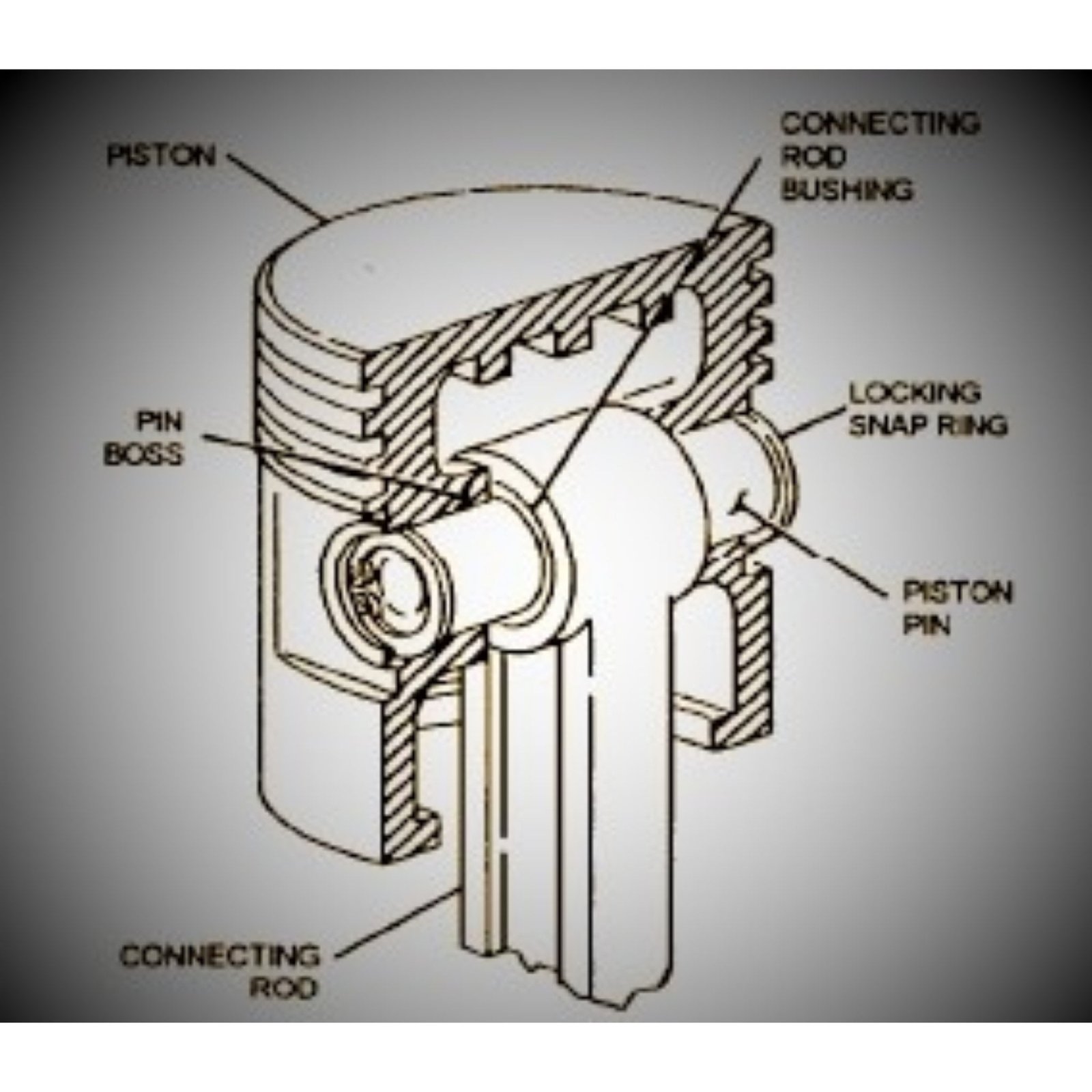
The supply of oil in the engine is produced to the bottom by means of oil holes in the crankshaft and thus through the connecting rod.

A non return valve may be fitted in the foot of this connecting rod to prevent back -flow of oil under gravitational force at the bottom of each stroke.
Where is gudgeon pin located ?
It can be fitted to the skirt of the piston and free to float and rotate, to limit axial movement.
The gudgeon-pin must be positioned relative to the piston so that it does not rub against or damage the cylinder.
Functions of Gudgeon Pin
The gudgeon pin (wrist pin, or piston pin ) connects the piston to the connecting rod and serves as a bearing for the connecting rod to pivot on as the piston moves.
Simply, it used to connect the piston to the connecting rod.
Q) What is the function of the piston pin?
a) To connect the piston to the crankshaft
b) To connect the piston to the piston head
c) To connect cam to the piston
d) To connect the piston to the connecting rod
Answer: d
Explanation: The major function of the piston pin is to connect the piston to the connecting rod. The piston pin is also called a gudgeon pin or wrist pin.
Constructions of Gudgeon Pin
The construction of gudgeon pin is usually a forged short hollow or solid rod made of a high strength and hardness steel alloy that can be physically separated from both the connecting rod and the piston or crosshead.
This pin’s ends are chamfered. This pin is held in place in the piston by a circular saw, and it is surrounded from the middle by the connecting rod’s small-bore end.
How gudgeon pin is designed
Designing a gudgeon pin is a quite challenging. The device used must be small and lightweight in order to not add unnecessary weight to the vehicle while also providing a comfortable fit to the often cramped quarters of the engine compartment.
It must also be strong and made of a metal that can withstand a lot of abuse. However, some manufacturers use rare metals to produce the gudgeon pins, whereas others rely on regular stainless steel that is forged under carefully controlled conditions.
The gudgeon pin is typically installed in a semi-floating or fully floating configuration, depending on the engine design. It is discovered acting as a bearing for the connecting rod, allowing rotational movement whenever the engine is running. Specialized versions are created for applications such as car racing, where engine components must be especially strong due to the engine’s high performance, which creates some unique demands.
When engines are inspected, which includes oil changes, tune-ups, and various other routine visits to the mechanic, it shows obvious signs of wear or tear on the engine’s components. If a problem is discovered within one of the components, such as a gudgeon pin, it is simple to replace. This could also indicate that there is an underlying issue with the engine that needs to be addressed properly.
It is critical to take engine problems seriously because ignoring them can lead to catastrophic failures of components or the engine itself. It is noted that the repairs are quite expensive, but it is also noted that it is less expensive to fix a problem than to wait for something else to break and incur the double expense.
Working of Gudgeon Pin
The engine’s development was quite rapid, and its performance improved significantly, resulting in a high demand for engine parts. The important parts of the engine, such as the piston, ensure the cyclic gas pressure and the inertial forces at work. However, the working conditions can be responsible for causing fatigue damage to the piston, such as a seat crack in the piston pin.
Previous research indicates that the highest stress is found on the top end of the piston pin seat, where stress concentration is one of the primary causes of fatigue failure. This is the reason that the piston’s working environment has become more complicated; on the one hand, the FEA for the piston has become more difficult.
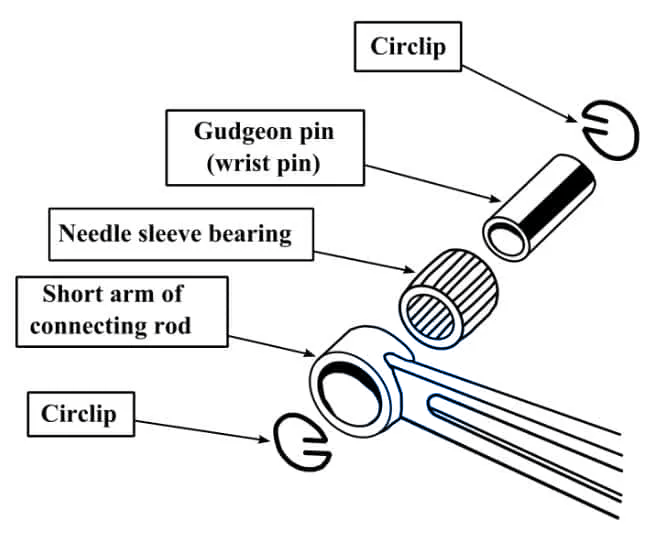
The gudgeon pin serves as a turning pair between the small end of the connecting rod and the piston. This can also turn the relative to the connecting rod, the piston bore, or both. The Gudgeon pin must have a sliding fit with both to cause seizure. Furthermore, because the Gudgeon pin is either a hollow or a solid steel cylinder with a length roughly five times its outer diameter and is subjected to only lateral load from the connecting rod, it should not be stressed beyond its bearing limit.
The piston pin is also used to connect the piston and connecting rods within the internal combustion engine, where the piston pin transfers gas pressure into the connecting rods. The rubbing pair is made up of a piston pin and a piston pin boss, and gas pressure is delivered to the rubbing pair via the piston pin and piston pin boss before the piston pin bends.
Types of piston pin
Design Options of Gudgeon Pin
A gudgeon pin typically comes in two design options. The design of a gudgeon pin is determined by technological and technical effectiveness.
- Stationery
- Semi floating
- Fully Floating
1. Stationary

The stationary pin is secured to the piston on the boss, and the connecting rod slides on the pin. Since all movement is made by the connecting rod, can occur uneven wear on the contact surfaces in this type of installation. Due to this, the use of this type of pin is not typical in diesel engines.
2. Semi- floating
The semi-floating pin is mostly fixed to the piston via an interference that fits with the journal in the piston. The connecting rod, which includes a small end bearing, acts as the sole bearing in this configuration, whereas the small end bearing requires only a bearing surface in this configuration.
This is accomplished through processes such as electroplating, in which the small end bearing journal is electroplated with a suitable metal, or by inserting a sleeve bearing or needle bearing into the eye of the small end, which is provided with an interference fit with an aperture of the small end. It is common practice to replace the bearing sleeve if it becomes severely worn.
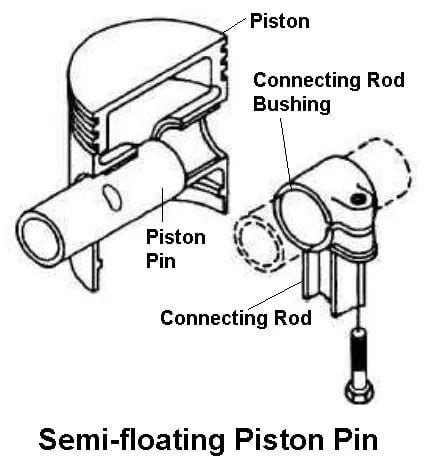
Aside from this configuration, there is a reverse configuration in which the gudgeon pin is fixed to the connecting rod rather than the piston, which is implemented by using an interference installed with the small end eye instead of the gudgeon pin journals in the piston, which functions as a bearing. It has been discovered that this arrangement is quite difficult to manufacture and maintain because both the bearing surfaces and the inserted sleeves complicate the design.
Aside from that, the pin must be precisely set so that the small end eye is in the centre. Because of the thermal expansion conditions, the arrangement was more popular for single-cylinder engines than for multiple-cylinder engines with long cylinder blocks and crankcases, until accurate construction became more popular.
3. Full Floating
Full floating pin configuration includes a bearing surface which is created within the small end eye of the gudgeon pin and the journal in the piston. T Circlips are commonly used to secure the gudgeon pins. There is no such interference found that fits in any case, and the pin floats on the entire bearing surfaces.
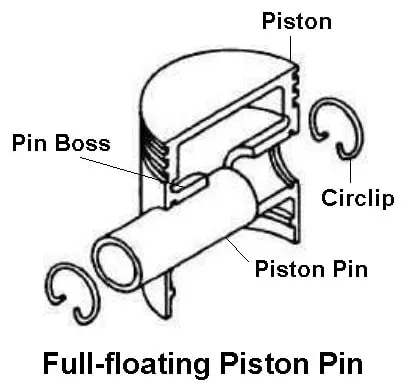
A gudgeon pin, also known as a wrist pin, is a critical component in an internal combustion engine. This is in charge of connecting the connecting rod and the piston. The Gudgeon pins are also accompanied by the connecting rod and the wheels or cranks. The term gudgeon pin originated in the United Kingdom, whereas it was known as a wrist pin in the United States and Canada. A variety of manufacturers produce gudgeon pins to replace worn pins.
The engine’s components include a short tube made of forged steel. During the entire running condition of an engine, the gudgeon pin is subjected to a great deal of force. It is discovered that it must successfully withstand thousands of piston firings in a very short period of time. The device is subjected to shearing and bending forces from the connecting rod as well as being subjected to an extremely high environment inside the engine.
Methods of designing of Gudgeon Pin
1.Semi-Floating Pinch-Bolt Small-End-Clamped Gudgeon-Pin
This is a method of fastening the rod to the pin in which the pin’s central portion incorporates a fully or partially formed circumferential groove. When the small end of the connecting rod is centrally aligned to this groove, the movement occurs within the gudgeon-pin and piston bosses. This method allows for the use of a narrow small-end, which increases the width of the rubbing surface within the piston and the gudgeon-pin boss.
2. Semi-Floating Force-Fit Small-End-Clamped Gudgeon-Pin
This arrangement includes the small end of the connecting rod, with its faces polished with emery cloth and heated evenly with an oxyacetylene torch at around 503 to 593 K, until there is a color difference found around the eye, ranging from pale-straw to dark-blue oxide. Following that, the gudgeon-pin is forced through both the piston and the small-end eye is centered. The small end cools the shrink over the pin while also keeping its relative rubbing movement within the pin and the piston bosses.
3. Semi-Floating Piston-Boss-Clamped Gudgeon-Pin
The gudgeon-pin is clamped to one of the piston bosses, and the connecting-small rod’s end is lined up with an interference-fit phosphor-bronze plain bush bearing. This bush aids in the location of the gudgeon-pin and thus provides a low-friction surface for it.
To avoid stripping the thread in the relatively soft alloy, take care when tightening the tapered locking bolt. When the bearing properties of the piston material are not suitable for continuous oscillatory rubbing or are not suitable as heavy-duty, this method is used.
4. Fully Floating Gudgeon-Pin End-Pads
It is recommended that the gudgeon-pins not be directly touched by the cylinder so that the very hard outer edges of the gudgeon-pins do not score the walls once they are allowed to float in their piston bosses.
There are various methods for preventing scuffing, such as spherical end-pads made of aluminum, brass, or bronze that act as a buffer between the walls and the pin. While these operations are ongoing, the gudgeon-pin is found revolving freely at both the small-end in the piston, which has a tendency to improve lubrication.
5. Fully Floating Gudgeon-Pin With Circlip Location
This gudgeon pin is constructed with fully floating Gudgeon pins that provide bearing surface area to the piston-boss bores as well as the small-end bronze bush bearing. Large pivoting angular movement and heavy thrust loads on the piston’s skirt are observed in the engines.
The fully floating pin’s double swivel action reduces the tendency of the gudgeon-pin to slide side by side under heavy-duty conditions. The clips are firmly secured in the internal circumferential grooves formed near the outer end of each gudgeon-pin-boss bore.
What is piston pin offset ?
This is the piston wrist pin, which is slightly offset from one side of the piston and should not be in the center of the piston. Consider the following two examples to better understand why this occurs:
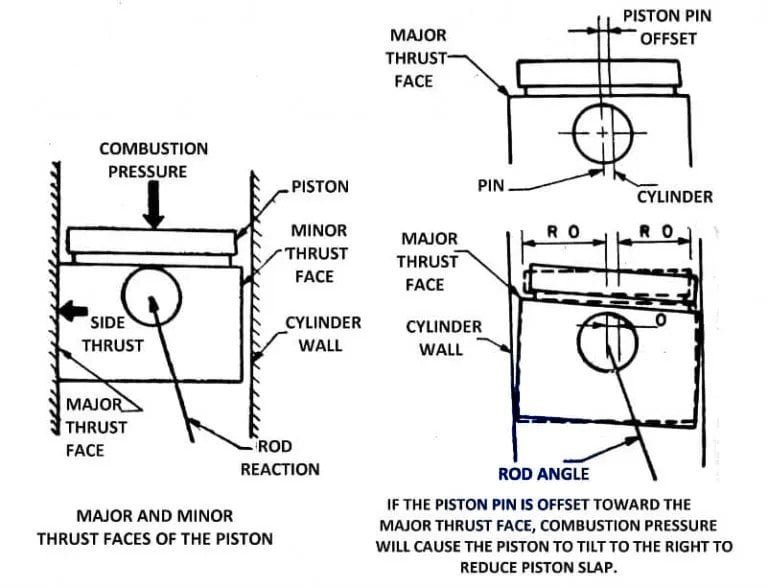
When the pin is in the center of the piston, the piston has arrived at TDC or BDC. The rod moves straight up and down in this position, putting a heavy load on it. To make the piston move again, the crank must move past TDC or BDC. This rods generates a significant amount of power and RPM from the engine.
With an offset pin, the piston wrist pin is slightly offset to one side of the piston, preventing the rod from moving straight up and down when the piston is at TDC or BDC. This allows the crank to rotate with less resistance, giving the engine more power and speed.
When the rod reaches the TDC or BDC, the offset pin relieves tension. The rod does not have to hit the piston both up and down. The rod moves in a more arcing motion.
Requirements of gudgeon pin
The following requirements must be met by the pin:
- The pin must be strong and flexible enough to withstand the load without being damaged.
- To achieve favorable wear behavior, a high surface hardness is required.
- For optimum fit with their sliding parts, piston, and connecting rod, these pins must have high surface quality and size accuracy.
- To keep inertia forces to a minimum, these pins must be light in weight.
- The pin’s rigidity should match the design of the piston to avoid overloading the piston.
- Regardless of what is stated above, the pin construction should be as simple and thus economical as possible.
Strength of piston pin
Pressure and tension loads act on the pin’s surface due to the impact of gas and inertial forces during working. As a result, the distribution of which is defined by the deformation of the piston pin bores, piston pins, and short end bore caused by forces.
As a result of the pressure distribution, the pin may be subjected to high bending, elliptical, and shear forces. This is compounded by a torsional load caused by the connecting rod tilting motion.
However, it is neglected due to the limited proportion of the total load. On the other hand, the pin must be as rigid and light as possible.
Stresses And Deformation Experienced By Gudgeon Pin
A Gudgeon pin experiences a high amount of deformations and stress, particularly in a reciprocating compressor used in an air braking system, as predicted scientifically whenever the pin is kept fully floating by surrounding it with lubricating oil and when starved of oil.
Both the analytical approach and the simple bending theory of beams are found in a finite element method, which is commonly used. The inadequacy of the beam approach is highlighted. The results obtained by both of them are precisely compared. The importance of clearance in the piston bore and the small end of the connecting rod, as well as the effectiveness of lubrication, is thoroughly investigated. The safety factor associated with the design of the Gudgeon pin is also closely examined.
Why is a gudgeon pin called a gudgeon pin?
The gudgeon pin is positioned in a sliding crosshead that is directly connected to the piston with a rod in previous versions of engines, such as those that were powered by steam and marine engines.
The word “gudgeon” is derived from the Middle French word “gojoun.”
What is the use of piston pin?
the use of piston pin to connect between the piston and the connecting rod.
Check Out Other Important Topics
| IC Engine | Important PDFs | Boilers | Synergy Maritime Exam | Naval Arch | MEO Class 4 |
| Interview Questions | Difference Between | Types of Pumps | Auxiliary Machines | Types of Valves | Home |

1 thought on “Gudgeon Pin (Piston Pin) – Types, Working, Function, Diagram”